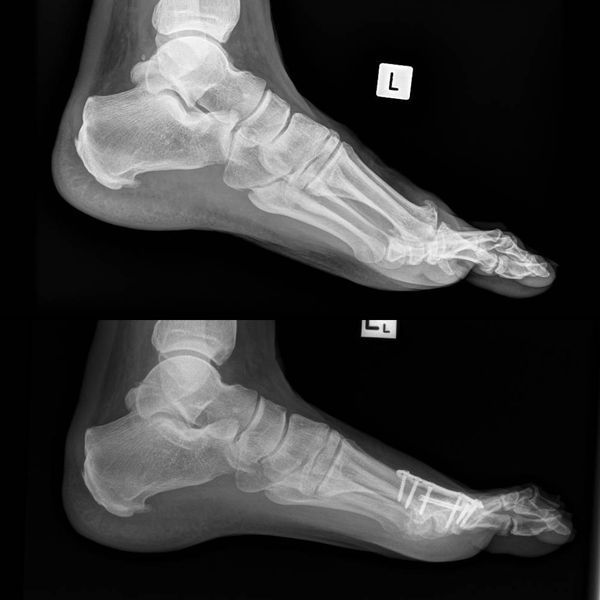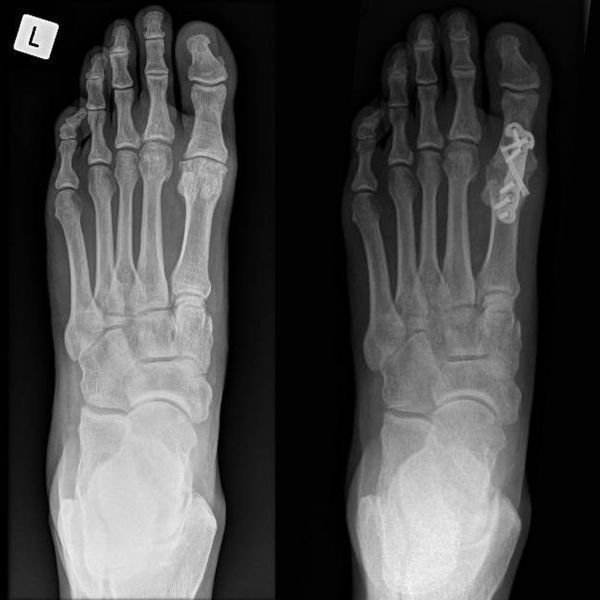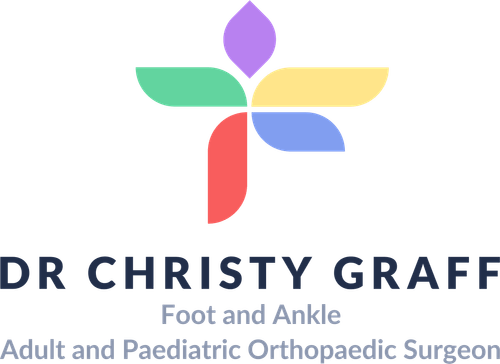Hallux Rigidus Surgery
What is Hallux Rigidus Surgery?
Hallux Rigidus surgery is a procedure to treat a condition affecting the big toe joint known as hallux rigidus. This condition is characterised by stiffness, pain, and limited movement in the big toe due to arthritis or degenerative changes in the joint. Surgery is typically considered when conservative treatments, such as medication, orthotics, or physiotherapy, fail to alleviate symptoms or restore mobility. Surgery aims to reduce pain, improve joint function, and enhance overall foot mobility.

Who is Suitable for Hallux Rigidus Surgery?
Individuals suitable for hallux rigidus surgery typically have the following characteristics:
- Severe Pain: Persistent pain that interferes with daily activities despite non-surgical treatments.
- Limited Mobility: Significant loss of movement in the big toe joint.
- Joint Damage: Advanced arthritis or degenerative changes confirmed through imaging.
- Failed Conservative Treatment: Ineffectiveness of non-surgical interventions such as orthotics, medications, or steroid injections.
- Good Overall Health: Adequate physical health to undergo surgery and recover without significant complications.
Benefits of Hallux Rigidus Surgery
- Pain Relief: Reduction or elimination of chronic pain in the big toe joint.
- Improved Mobility: Enhanced ability to move the toe, walk, and perform daily activities.
- Better Quality of Life: Increased comfort during walking, running, or wearing shoes.
- Customised Solutions: Surgical options tailored to the severity of the condition, ensuring optimal outcomes.
- Prevention of Further Damage: Stabilization or reconstruction of the joint to avoid worsening arthritis or deformities.
Types of Hallux Rigidus Surgery
The type of surgery recommended depends on the stage of hallux rigidus and the patient’s specific needs. Common types include:
- Cheilectomy:
- Removal of bone spurs and damaged tissue around the joint.
- Best suited for early-stage hallux rigidus with mild arthritis.
- Arthrodesis (Joint Fusion):
- Fusing the bones of the joint to eliminate movement and pain.
- Ideal for severe arthritis where joint preservation is not feasible.
Alternative Options to Hallux Rigidus Surgery
For patients who may not be ready for surgery or prefer non-surgical approaches, several alternatives can help manage symptoms:
- Medication: Anti-inflammatory drugs or corticosteroids to reduce pain and inflammation.
- Orthotics and Footwear Modifications: Custom insoles, stiff-soled shoes, or rocker-bottom shoes to reduce joint stress.
- Physiotherapy: Stretching and strengthening exercises to improve joint function and reduce stiffness.
- Steroid Injections: Temporary pain relief and reduced inflammation in the affected joint do not remove the underlying problem.
- Activity Modification: Avoiding activities exacerbating symptoms, such as high-impact exercises or prolonged standing.
Preparation Before Hallux Rigidus Surgery
Proper preparation for hallux rigidus surgery helps ensure a smooth procedure and recovery. Steps include:
- Consultation with Dr Graff: Dr Graff will evaluate the condition, review imaging, and discuss the appropriate surgical approach.
- Pre-Surgical Tests: Blood tests, imaging (X-rays or MRI), and other necessary evaluations to confirm suitability for surgery.
- Medication Review: Inform your surgeon about any medications you are taking. You may need to adjust or stop certain drugs, such as blood thinners.
- Lifestyle Adjustments: Cease smoking to promote better healing. Maintain a healthy diet and exercise routine to optimise physical condition.
- Arrange Post-Surgery Support: Organize transportation and home assistance for the recovery period. Prepare your home with essentials like crutches or a walker.
Hallux Rigidus Surgery Procedure
- The surgery involves an incision on the inside of the big toe and foot.
- Any remaining cartilage is removed from the joint so that bone can grow into the bone and become like one bone.
- The joint is put together in the correct position and held with a plate and screws.
- Sometimes, the lesser toes (2-5) may also need a procedure.


The Hospital Stay
- You wake up with bulky bandages and a post-op Darco shoe.
- Your foot will be elevated overnight, and you have antibiotics through a drip (you may go home the same day if your surgery is in the morning).
- Depending on your medical conditions, you may need blood thinners to prevent clots and 1 g of vitamin C daily for 6 weeks.
- The next day, you can walk on your foot in the Darco shoe, but only for necessary things like going to the toilet. Otherwise, your foot will become swollen.
At Home
- You will need medications for pain relief; please take two panadol with meals and at night. The first night after surgery is often when the worst pain is experienced. Please take a stronger painkiller before you go to bed on the first night after surgery.
- You will need either blood thinners to prevent blood clots and vitamin C 1g daily for 6 weeks.
- Please leave all dressings intact until your appointment with Dr Graff.
- Dr. Graff will see you at your post-op appointment in 2-3 weeks. The wounds will be examined there, and the sutures will be removed/trimmed (absorbable sutures are often used).
- After this, you can shower normally and pat the dressings dry.
Hallux Rigidus Surgery Rehabilitation
All patients are different. These timelines are only guides; some patients may progress faster or slower than others. The rehab may also be slower if both feet have surgery simultaneously.
0 - 2 Weeks
- You can weight bear in your Darco shoe, but only for essential activities such as getting food or going to the toilet.
- Keep the dressings on at all times like a plaster.
- You can remove the Darco shoe to sleep and rest.
- Pain relief: Please take regular Panadol with meals and before bed.
- Please take blood thinners and vitamin C as prescribed.
2 - 3 Weeks
- At your post-op appointment with Dr Graff, dressings are changed, and an x-ray is taken
- You can then shower (you may need a shower chair) and start range of motion exercises of your ankle with physio (not of your toe)
6 Weeks
- You will have an appointment with Dr Graff and an x-ray
- You can start to wear normal shoes if your swelling is OK
12 Weeks
- You will have another appointment with Dr Graff and an x-ray.
- You may be feeling more ‘yourself’, but you can continue to have swelling (especially at night) for several more months
- The final results of surgery are only felt 4-6 months postoperatively.
When can I return to work/school?
- 3-4 weeks if your job requires seated work and you can drive (if you drive to work)
- 10-12 weeks if your job requires prolonged standing
- 3-6 months if your job requires heavy labour
When can I drive?
- 2-3 weeks if the surgery is on your left foot (if you drive an automatic car)
- 6 weeks if surgery is on your right foot (when you are no longer in the shoe)
When can I return to sport?
- It will take 3-4 months, but this is a transition. Start with walks, then running, and then training. Your physiotherapist can guide you on when your strength and range of motion will return to normal so that you can return to competitive sport.
Hallux Rigidus Surgery Prognosis
The prognosis for hallux rigidus surgery is generally favorable:
- Most patients experience significant pain relief and improved mobility.
- Arthrodesis offers reliable results for severe arthritis, while cheilectomy preserves or restores joint movement.
- Following post-operative care and physical therapy greatly enhances outcomes and minimises complications.
Hallux Rigidus Surgery Risks
While the procedure is typically safe, potential risks include:
- Anaesthetic problems
- Nerve injury
- Blood clots
- Infection
- Stiffness
- Recurrence
- Ongoing pain
- Not healing
- The fusion healing in the wrong position
- Further surgery
What if Hallux Rigidus Surgery is Delayed?
Delaying surgery can lead to:
- Progressive Joint Damage
- Worsening Pain
- Reduced Mobility
- Impact on Other Joints
- Limited Treatment Options
For those unsure about surgery, close monitoring and conservative treatments can help manage symptoms until surgery is necessary.
Please see the ‘Hallux Rigidus’ Information sheet here.
If you want more information or have any questions or problems, please contact Dr Graff at admin@christygraff.com or call the rooms at 0493 461 133.
